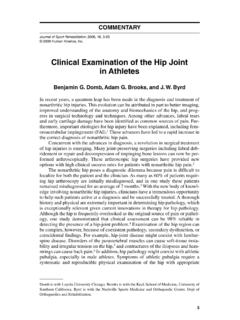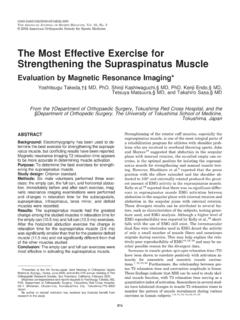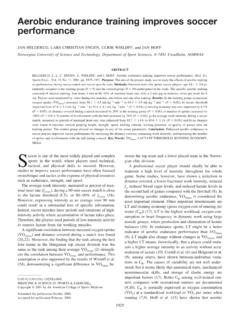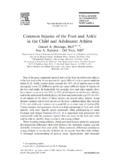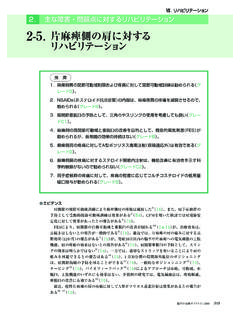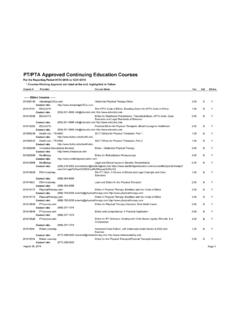Transcription of ORIGINAL ARTICLE Hemiplegic Shoulder Pain …
1 1589. ORIGINAL ARTICLE . Hemiplegic Shoulder pain Syndrome: Frequency and Characteristics During Inpatient Stroke Rehabilitation Alexander W. Dromerick, MD, Dorothy F. Edwards, PhD, Ashok Kumar, MD. ABSTRACT. Dromerick AW, Edwards DF, Kumar A. cine and the American Academy of Physical Medicine and Hemiplegic Shoulder pain syndrome: frequency and character- Rehabilitation istics during inpatient stroke rehabilitation. Arch Phys Med Rehabil 2008;89:1589-93. F RECENT SCIENTIFIC FINDINGS regarding activity de- Objective: To clarify the pathophysiology of Hemiplegic Shoulder pain by determining the frequency of abnormal shoul- Ivant,pendent 1,2.
2 Neuroplasticity and recovery are clinically rele- then the Hemiplegic Shoulder pain syndrome takes on new der physical diagnosis signs and the accuracy of self-report. importance in stroke rehabilitation. The presence of pain dis- Design: Prospective inception cohort. courages movement and might hinder recovery. The effective- Setting: Academic inpatient stroke rehabilitation service. ness of any motor restoration technique will be diminished if Participants: Consecutive admissions (N 46) to stroke re- patients cannot tolerate active or passive Shoulder movements, habilitation service. and these people may be deprived of recovery they might Interventions: Not applicable.
3 Otherwise have had. Thus, Hemiplegic Shoulder pain will need Main Outcome Measures: The Neer test, Speed test, acro- to be effectively prevented or treated so that it does not become mioclavicular shear test, Rowe test, and palpation for point a practical roadblock to implementation of newer upper- tenderness. extremity rehabilitation strategies. Results: Participants were enrolled at a mean time to eval- The reported frequency of Hemiplegic Shoulder pain syn- uation of days after stroke. Weakness of Shoulder drome varies from 5% to 84% of stroke Despite the flexion, extension, or abduction was present in 94% of subjects, high frequency of Hemiplegic Shoulder pain syndrome, the and neglect was found in 29%.
4 pain was present by self-report literature is full of conflicting reports about the epidemiology, in 37%. The most common finding, which was found in nearly risk factors, and etiology of Hemiplegic Shoulder pain syn- all persons with abnormalities in the study physical examina- drome. Symptoms can appear in the first weeks after the stroke, tion maneuvers, was bicipital tendon tenderness (54%), fol- or develop much ,7 Risk factors for Hemiplegic Shoulder lowed by supraspinatus tenderness (48%). The Neer sign was pain syndrome identified in the literature include glenohumeral positive in 30%; 28% had the triad of bicipital tenderness, subluxation, hemineglect, spasticity, flaccidity, and prior shoul- supraspinatus tenderness, and the Neer sign.
5 Self-reported pain der Several clinical diagnoses have been pro- was a poor predictor of abnormalities elicited on the examina- posed as causes of Hemiplegic Shoulder pain syndrome, includ- tion maneuvers, even in those without neglect. ing rotator cuff tendonitis or tears, subacromial bursitis, Conclusions: Our data implicate 2 vertical stabilizers of the bicipital tendonitis, diffuse Shoulder pain or adhesive capsuli- humerus in early onset Hemiplegic Shoulder pain , the long head tis, brachial neuralgias, sympathetically mediated pain , and of the biceps and the supraspinatus. Our results also suggest referred The presence of Hemiplegic Shoulder pain that simple questioning of stroke rehabilitation inpatients about syndrome is associated with poorer motor recovery, though a Shoulder pain may not be adequate for clinical care or research causal link has not been ,8.
6 Purposes, even in the absence of neglect. One approach to clarifying Hemiplegic Shoulder pain syn- Key Words: Cerebrovascular accident; Joint diseases; Phys- drome would be to determine which Shoulder structures act as ical examination; Rehabilitation; Shoulder ; Shoulder pain ; pain generators at any given time after stroke. Objectively Stroke. classifying the symptoms experienced by persons with hemi- 2008 by the American Congress of Rehabilitation Medi- plegic Shoulder pain syndrome would be an important step toward understanding the pathophysiology of this condition. Ideally, such an assessment would be reliable, simple, and done at the bedside to minimize expense and time away from ther- apies.
7 From the Departments of Rehabilitation Medicine, National Rehabilitation Hospi- We have recently shown interobserver reliability of an ex- tal, Georgetown University, Washington, DC (Dromerick); and Division of Physical amination of many of the soft tissue structures of the Shoulder Medicine and Rehabilitation and Department of Neurology (Dromerick, Kumar, joint commonly thought to participate in pain generation after Edwards), Programs in Occupational Therapy (Dromerick, Edwards), and Physical Therapy (Dromerick), Washington University School of Medicine, St. Louis, MO. We now describe the use of this evaluation to catalog Supported by the Missouri Arthritis Foundation, the National Institute for Neuro- the clinical phenomena of Hemiplegic Shoulder pain syndrome logic Diseases and Stroke (grant no.)
8 NS41261), and the James S. McDonnell Foun- involving these structures during inpatient stroke rehabilitation. dation (grant no. 21002032). We hypothesized that patients would accurately self-report No commercial party having a direct financial interest in the results of the research supporting this ARTICLE has or will confer a benefit upon the authors or upon any organization with which the authors are associated. Correspondence to Alexander W. Dromerick, MD, Dept of Rehabilitation Medicine, List of Abbreviations Georgetown University School of Medicine, National Rehabilitation Hospital, 102. Irving St NW, Washington, DC 20010, e-mail: ACJ acromioclavicular joint Reprints are not available from the author.
9 MAS Modified Ashworth Scale Published online July 2, 2008 at MRC Medical Research Council 0003-9993/08/8908-00138$ NIHSS National Institutes of Health Stroke Scale Arch Phys Med Rehabil Vol 89, August 2008. 1590 Shoulder pain DURING STROKE REHABILITATION, Dromerick when they had elicitable pain , and that we could sort them into Table 1: Participant Characteristics (N 46). different subgroups based on which soft tissue structures were Characteristics Values found to be involved on physical examination. Understanding the different subgroups would lead to a deeper understanding Age (y) (33 78). of the pathophysiology of Hemiplegic Shoulder pain syndrome Male subjects 24 (52).
10 And thus toward improved treatment. Prior nondisabling Shoulder pain 7 (15). Prior stroke 13 (28). METHODS Stroke location This was a prospective cross-sectional study done in an Left 24 (52). academic stroke rehabilitation program, and was approved by Right 22 (48). the Washington University Human Studies Committee. All Dominant side affected 23 (50). persons admitted for stroke rehabilitation during the 3-month Shoulder weakness present study period were included in this study, except those who Flexion 39 (85). refused, were unable to follow 1-step commands, or could not External rotation 40 (87). provide informed consent.
